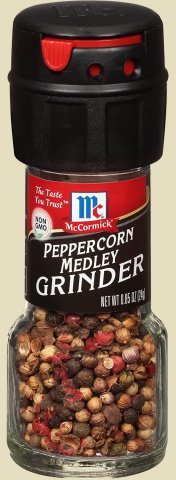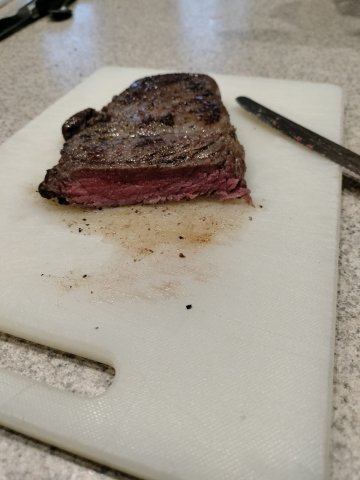I've featured the Lex Fridman podcast once before, his interview with former Soviet spy Jack Barsky. Fridman's podcasts are an amazing experience, not only because Fridman is both very intelligent and very interesting, but because he features guests who are the same. I'm not sure if he just choses exceptional guests, or if his interview technique makes them interesting. One thing I love: he lets them talk. No sound bites here. Fridman brings up a question, and he lets his guests run with it. Unfortunately, the side effect is that his shows are three hours long. But at least they work well split up into parts, which is what we usually do.
This video is from his interview with Canadian psychologist Jordan Peterson. Of course it is all interesting! But what I'm highlighting here is Peterson's personal diet, probably contrary to his wishes, since he says he doesn't like to talk about it and doesn't generally recommend it. The relevant part of the video is 2:03:06 to 2:10:19. This segment was introduced earlier, when he was asked if he started his day with coffee, and he replied, "Steak and water."
All this is very interesting, but the real point of this post is this steak that our oldest grandson just made with his new steam oven:
And this, also made in the steam oven, is why I'm not excited by Jordan Peterson's diet, even with infinite steak.
Everybody knows and loves bagels. But would you believe I'd never eaten, seen, or even heard of bagels until I went to college?
My foodly-wise roommate from Providence, Rhode Island was shocked at my ignorance, but I learned in this video, with its brief history of bagels and interview with an old-time bagel baker, that bagels were largely unknown outside of the New York City area during the 1970's, and didn't really take off in the rest of the country until the 80's. Gong to college put me ahead of the game because of where I went to school. The University of Rochester is in Upstate New York, but it attracted many people from New York City, and in particular many Jews. Lox and bagels came with them.
I've written about the Pro Home Cooks YouTube channel before. This video is from its earlier days, and still fascinating. In it Mike Greenfield recreates the bagel-and-lox sandwich that was his childhood staple, and he does it almost entirely from scratch.
He makes the bagel.
He makes the lox.
He makes the cream cheese.
If he were making this show now, he would no doubt have grown his own tomatoes and onions, and for all I know pickled his own capers, but he's not there yet.
It's a cooking show with a side dish of history and culture. I hope you enjoy it. (22 minutes, works well at 1.5x speed)
It's been a while since I've shared a favorite YouTube channel, and this one comes with a warning: It will make you hungry!
The channel is Pro Home Cooks, founded by Mike Greenfield. I've been salivating over it for some time, but the video that directly inspired this post is This Fried Chicken Recipe Took Over NYC (9,000 Waitlist) (16 minutes).
You can easily find lots of good cooking videos on the channel, so to round out this post I'm choosing a couple that show a little more about the life behind the shows. The first is a 17-minute "day in the life" video.
Finally, this is a very short (one-minute) video in a different format, but it gives a view of his very enviable garden.
I hope you enjoy Pro Home Cooks as much as I do.
I've admired Joel Salatin and his Polyface Farms for a long time, but many years have passed since I first read Everything I Want to Do Is Illegal. I'd lost track of him in the ensuing years, but he recently popped up after another YouTube video, in this Hillsdale College lecture. I hope you enjoy it; that man is right about many things. (15 minutes)
Sometimes you have to post about all the terrible things happening in the world, and sometimes you just have to post about ... chocolate. Ann Reardon and How To Cook That present, "How big companies RUINED chocolate!" (17 minutes—have a taste!)
I don't remember where it was; Porter is sure it was somewhere in Switzerland, but neither of us can recall the city, let alone the store. What we do remember was that we bought several large bars of chocolate from specific countries, such as Venezuela, Panama, Ghana, and Cuba. If we'd known how great an experience that would be, we'd have bought a lot more, that's for sure. Porter's absolute favorite was the chocolate from Cuba; unfortunately, on our one adventure to that country, they were all trying to sell us alcohol and cigars, not the Good Stuff.
For much of my life, chocolate meant either Nestlé or Hershey. Nestlé tasted better, but Hershey gained points after I moved to Pennsylvania.
Eventually, Nestlé fell out of favor because of the way they push their infant formula, especially in third-world countries. Not to mention the fact that they suck massive amounts of water out of our Floridan Aquifer for their bottled water.
Hershey fell out of favor because, well, because Swiss chocolate is just better, period. And my chocolate budget grew bigger.
Now Hershey has given me more reasons to stick with my Toblerone, Ovomaltine (NOT the Americanized junk of similar name), and other amazing Swiss brands. I've also grown fond of Ghirardelli, though it doesn't pay to look too closely at their corporate values, either. I try to judge products by their quality rather than their politics, as long as the company's political views aren't shoved in my face.
Annoyed as I am with Hershey, which is doing just that, they've also, albeit indirectly, given me this comedy sketch, so I thank them. (And it's not even the Babylon Bee this time.)
However, I'm not going to be shopping at ihatehersheys.com. My chocolate budget isn't that big.
A year ago, I picked and washed some fruit from our Page orange tree, then used a vegetable peeler to obtain thin slices of peel. These I put into a glass jar, which I then filled with plain vodka. That, plus time, produced an awesome orange extract.
It's not something I would drink—I wouldn't drink vodka anyway—but as a flavoring I say it's great, and I have the dark chocolate orange fudge to prove it.
This year's harvest is now mellowing in its vodka marinade, and I'm trying another as well, using peel from the Meyer lemons that were a gift from a friend. (The Meyer lemon, by the way, is a hybrid, 25% pomelo, 25% mandarin, and 50% citron; the Page orange is 25% grapefruit and 75% tangerine.)
 Being a household of two, we can't keep bread goods out on the counter as we once did; all too often they spoil before we can finish them. Thus, when I bring them home from the grocery store, they often go directly into the freezer, to be thawed as needed.
Being a household of two, we can't keep bread goods out on the counter as we once did; all too often they spoil before we can finish them. Thus, when I bring them home from the grocery store, they often go directly into the freezer, to be thawed as needed.
That's a mistake, I've discovered. The directly part, I mean. Perhaps you've known this trick all along, but if it's new to me, it's undoubtedly new to someone else, so worth publishing.
Now when I come home with bagels, or English muffins, or anything else I might want to use by parts, I divide them before putting them in the freezer. It's only a matter of seconds to cut a bagel in half, but what a difference it makes when I want to have one for breakfast, if it comes from the freezer pre-sliced. I can take just a half if I want (when did bagels get so big, anyway?), or pop two halves directly into the toaster instead of waiting for them to thaw enough to be sliced. Even bagels that come (mosty) presliced in the package can benefit from this treatment, as I find they're inclined to stick together too much without it.
This is a great convenience, and if there's a down side I haven't yet encountered it. Perhaps the additional exposed surface is more prone to drying out, but I've not yet had the problem.
Who says vegetables have no feelings? That's a hug if I ever saw one.
I thought "caduceus," but Siamese twins is another possiblity. All body parts were intact; unfortunately, I was unable to separate them without damage.
Heartless omnivore that I am, after my unsuccessful surgery, I ate them.
They were delicious.
Since COVID isn't so much of a problem in New York City anymore, Mayor Eric Adams and New York City Health & Hospitals CEO Dr. Mitchell Katz have come up with a new way to terrorize those who must be admitted to a Big Apple hospital. At the moment, it's just three facilities: H+H/Lincoln, Metropolitan, and Woodhull Hospitals, but it's feared the contagion may spread.
If you're unfortunate enough to be admitted to one of those hospitals, keep an eye on your dinner plate.
Culturally diverse plant-based meals are now the primary dinner options for inpatients.
Don't panic, NYC residents and visitors. I'm here to reassure you that this problem is not actually new, and there are ways around it.
Back in the mid-1980's, when we moved to Florida, we were warned that our local hospital was run by Seventh-Day Adventists, and consequently meat was never on the menu. The solution, we were told, was to be sure that your doctor provided you with a prescription for meat. I have no idea if making it a prescription increased the cost of meals fifty-fold, or if any insurance plans covered it. But we were assured that the hospital honored the doctors' orders, and the kitchen staff even did a better-than-usual job of preparing the special meals.
Apparently the same work-around will be honored in New York.
Non-plant-based options continue to be available and are offered in accordance with a patient’s prescribed diet.
Choose your doctor well.
Permalink | Read 1058 times | Comments (0)
Category Health: [first] [previous] [next] [newest] Politics: [first] [previous] [next] [newest] Children & Family Issues: [first] [previous] [next] [newest] Food: [first] [previous] [next] [newest]
Sometimes, you just have to make a meme. It's so much more fun than getting angry about the relentless and ubiquitous anti-meat propaganda these days.
In my review of Michael Pollan's book, Cooked, I noted what a professional chef told him about using salt.
"Use at least three times as much salt as you think you should," she advised. (A second authority I consulted employed the same formulation, but upped the factor to five.) Like many chefs, Samin believes that knowing how to salt food properly is the very essence of cooking, and that amateurs like me approach the saltbox far too timorously. ...
Samin prefaced her defense of the practice by pointing out that the salt we add to our food represents a tiny fraction of the salt people get from their diet. Most of the salt we eat comes from processed foods, which account for 80 percent of the typical American's daily intake of sodium. "So, if you don't eat a lot of processed foods, you don't need to worry about it. Which means: Don't ever be afraid of salt!"
Clearly, chef Gordon Ramsay agrees. Spend three minutes watching this video of him demonstrating how to make the "perfect burger" at home, and you'll see him seasoning the creation—adding salt and pepper in generous quantities—seven separate times:
- burger side 1
- onions
- burger side 2
- burger again
- cheese 1
- cheese 2
- lettuce
After assembling the burger he finishes it with one more healthy dose of pepper.
If you're wondering why it is that hamburgers from your favorite restaurant taste so good, take note, and see if using a freer hand with seasoning makes a difference to your home cooking.
What I still don't understand, however, is how one eats such a creation. It looks fantastic, but who has a mouth that can get around such a thing? We're not snakes! That's my problem with restaurant burgers, which taste so good but which I can't manage to eat without requiring a fork to clean up everything that oozes out the sides, followed by a large stack of paper napkins and/or a trip to the restroom to wash my hands. Any suggestions?
 The only thing I don't like about McCormick's Peppercorn Medley Grinder is that it isn't refillable, which seems like such a waste.
The only thing I don't like about McCormick's Peppercorn Medley Grinder is that it isn't refillable, which seems like such a waste.
The flavor, however, is fantastic! In the past, I was a very modest pepper user; now I find myself grinding this on so many foods and in much greater quantity than before. It's that delicious.
This mix, which in our local Publix is found in the spice section with the pre-filled pepper and salt grinders, includes black peppercorns, coriander, pink peppercorns (which, I understand, aren't actually pepper), white peppercorns, allspice, and green peppercorns.
I highly recommend this spice blend to everyone, except my one friend who is allergic to pepper and my other friend who is allergic to coriander/cilantro. Everyone else—do give it a try.
Here's another Gordon Ramsay video, especially for our grandson the aspiring dessert chef, whose other grandparents have a plentiful supply of rhubarb growing in their garden (in season). I am envious that Ramsay lives where rhubarb is plentiful and cheap!
The previous language warning applies to whatever random video might come after this on YouTube, but this one is fine.
Having finally discovered how to embed a piece of a YouTube video, I can't resist showing a few seconds of chef Gordon Ramsay inadvertently demonstrating what I've been told again and again about chefs' seasoning measurements: they're much more generous than home cooks imagine.
The good news is that even with these larger quantities, home-cooked food usually contains less of these ingredients than processed foods and what you get at most restaurants.
Here's the whole video (15 minutes). Be forgiving of the camera work here: instead of his usual crew, his children are doing the work. They are about the only ones who get to talk back to Gordon Ramsay.
I find Chef Ramsay very interesting to watch. Here's his YouTube channel. Apparently he has a bunch of television shows as well, but not on any channel we can get that I've discovered. I've learned a lot watching what I can, however—from cooking tips to what makes a good restaurant or hotel.
Ramsay comes with a big warning, however: his language is appalling. He can clean it up when he wants to, as this video with his children attests. But what's available on YouTube is all over the map: from clean to bleeped out to uncensored. You all know how much I object to such language, but I find that in his videos it is so incredibly common it's laughable, and almost as impotent as "um" or "like" in other people's usage. It's more incredibly annoying than offensive—like his use and overuse of the word "literally." So far I've been willing to put up with annoying for the learning experience.







